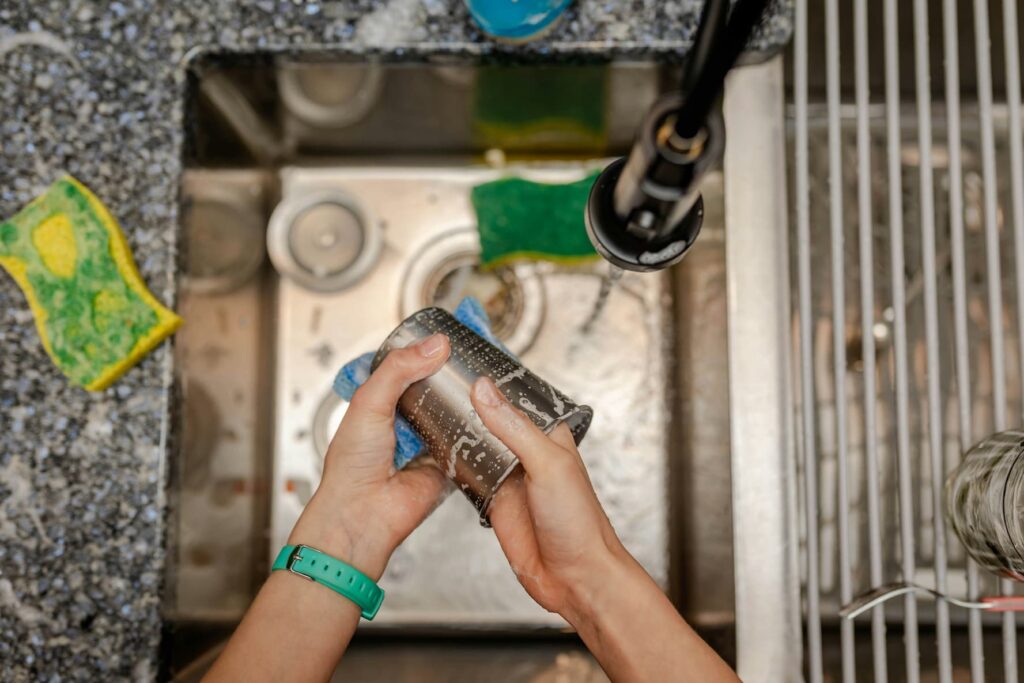Dishwashing is the bane of my existence; it hurts my back and it is never ending. It is something that many homemakers relate to. Fortunately, getting a dishwasher eliminated some of the issues that dishwashing causes me, but sometimes my dishwasher doesn’t get things clean enough and I need to wash things in another cycle or by hand. This is incredibly frustrating.

In addition to being annoying, dishwashing can be really wasteful of water if not done efficiently, and when every penny counts, spending more on washing your dishes makes a difference.
Here’s how you can wash your dishes faster, and still have clean dishes.
Cleaning the dishes is probably the most mundane business in any home, but at times, it always seems to consume more time than it has to. The process can be used with both hands, as well as with the use of a dishwasher, but the idea is always to make dishes get a complete treatment in terms of cleaning, as well as sanitizing. Nevertheless, most individuals end up having to hurry through the procedure leaving unattended territories or spend too much time trying to be precise. Having a perfect balance between fast and clean is not so impossible when a few clever tricks and a regular schedule are applied.
With a new approach to dishes, any person can accelerate it, and despite the elevated requirements in terms of their cleanliness. Small corrections can result in great time savings, and this is true as far as improvement of organization, the correct technique of soaking, efficient utilization of tools, etc. Households that use dishwashers can also use some improvements on how they load a dish washer and the product used including the quality of the dishwasher pods.
Organizing Before Washing
The first thing to keep in mind before the actual process of dish washing begins is that there is a lot to be saved in time by simply preparing everything in hand prior to the actual process of dish washing. Putting similar items together also makes a more systematic flow- utensils, glasses and plates. This will enable you to clear the cleaning in a logical sequence instead of you always interchanging shapes and materials, which have the likelihood of delaying you.
It is also significant to remove food scraps and clean the surface by scraping the components on the surface so that they do not make contact with water. Sorting and scraping eliminate the need to scrub more in the future. It does not make water get milky and oily in a short amount of time, so the process of washing is effective at the very beginning. Items that are heavily coated can also be loosened by a quick pre-rinse to make food stuck to them more easily scrubbed off saving energy and time in the end.
Using Effective Tools And Supplies
The selection of the right set of dishwashing tools may have an observable effect of the speed. Debris can also be cleared easily and quickly with a high quality sponge or scrub brush or sponge-like dishwand without having to keep on repetition. The soft but abrasive utensils that can suit any kind of surface will ensure the dishes will be clean and within the shortest time possible. Having well maintained and clean tools guarantees that the instruments are going to work properly every time.
Using the right soap or detergent also matters. The ability to provide sufficient suds, clean grease in products, and to rinse easily keeps the workflow quicker. At the time of implementing a dishwasher, choosing powerful dishwasher pods will make sure dishes are clean without the necessity to wash the dishes again. Quality goods prevent the inconvenience of finding half-dried products by the time the drying is over.
Maintaining An Efficient Flow
A continuous workflow goes a long way in accelerating the process. Clean small items including glasses and utensils first and then wash the pots and pans, which are the dirtier ones. This helps stop the spreading of greasy residue to the other dishes and ensures that your cleaning water will not get staler over time. This order is also useful to prevent the possibility of having to replace water or rewash.
Keeping both hands active also increases speed. The use of both hands could be a scrubbing one and the other one of holding or rinsing. Keeping the rhythm going and limiting the amount of needless motions such as setting down objects several times will keep one going. Although this kind of flow would take time to get accustomed to, it would be like second nature and thus several minutes would be saved in each session but at the same time would not affect the results.
Saving Time With Soaking And Pre-Treatment
Dried-on food and unwanted stains may easily hijack a well-organized way of washing dishes. Time consuming scrubbing can be avoided by simply letting the pots and pans sit in warm soapy water after which residue can be easily loosened by the water, making cleaning this simple task go much quicker. A small soak in the beginning phase of dish cleaning would help to make those things easy to clean in future.
It is also useful to apply a small quantity of dish soap on the trouble areas and then clean it with a cloth. Waiting with the soap will enable other substances to be washed and give the solution the ability to dissolve grime better. Such techniques minimize the amount of physical work and accelerate the whole cleaning process even in the case of a heavily utilized cookware.
Making The Most Of The Dishwasher
During dishwashing machine usage, the loading process is very important in the washing process. When dishes are arranged in a good order, all surfaces become exposed to water and the detergent. Avoid congestion, blocked spray arms and failure of soap to get to all items. Loading and unloading is also made quick using size and shape arranging.
It is also necessary to choose the proper cycle and detergent. The pods of modern dishwashers are created in a way that dissolves at the right moment and releases the cleaning substances. One will be able to choose high-performance pods in order to get dishes out after the first run. A combination of good loading habits together with good products make the dishwashing steps efficient at every instance.
Cleaning As You Go
Cleaning when cooking can be considered as one of the most painless ways of saving time used in cleaning up. As one uses the tools, one can wash or rinse them instead of postponing everything to the end and consequently, there is no huge stacking pile. Such a practice decentralises the workload, and the kitchen is kept clean as dinners are cooked.
Even such minor tasks as washing mixing bowls immediately after using or putting dishes in the dishwasher as the food is being cooked help shorten and simplify the work at the end of the meal. By making the dishwashing a part of the cooking routines, it seems to be less daunting a task to handle, and there is no longer a massive effort at one end.
Conclusion
Everything boils down to working smarter on how to wash dishes faster and still deliver a cleaner job. Such minor adjustments as sorting items in advance, having effective tools and using dishwasher pods when necessary can make a huge difference. However, if you wash the dishes manually or use a dishwasher, the truly effective work routine will guarantee clean dishes with fewer efforts and time. Using some considerate steps and techniques, one can easily make dish-washing an enjoyable less time-consuming process of the kitchen routine.





